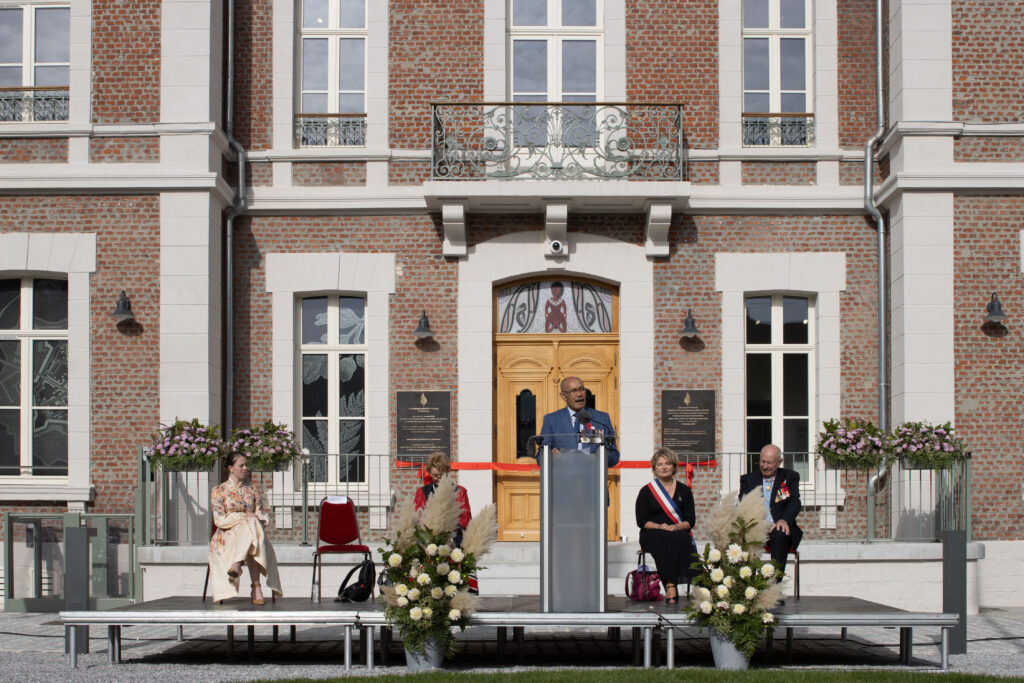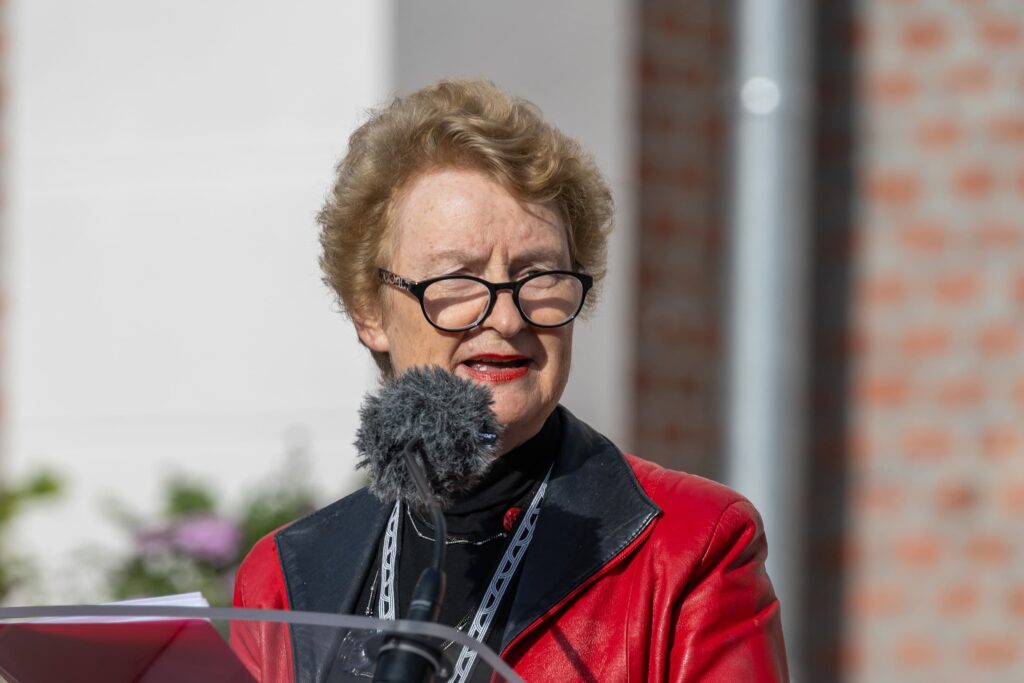
WELCOME FROM STRATEGIC ADVISOR TO THE TRUST – CELIA CAUGHEY
Welcome distinguished guests and friends to this very happy and long-awaited day, the opening of our New Zealand Liberation Museum. It is in our history that we find our future wellbeing. Special welcome to descendants of those who were in Le Quesnoy at the time of the battle: the Tapsell whanau, and we welcome Petera, Winiata Tapsell’s son, the Barrowcloughs, the Jardines, the Allens, the Wilsons and of course the Averills, as well as many more – and those from Le Quesnoy.
Ti hei mauri ora!
E ngā mana, e ngā reo, e nga rangatira rau, tena koutou.
Ki a Ranginui e tū nei, ki a Papatūānuku e takato nei, ki ngā ātua katoa i waenganui, tēnā koutou.
E te hunga mate, moe moe rā, moe moe rā.
Nau mai, haere mai ki tēnei hui, ki te whakatau o tenei whare-taonga, a Te Arawhata.
Ki a te whānau Tepehana, tena koe Petera, ki a koutou, te Runanga o Ngati Wae Wae, tēnei te mihi aroha ki a koutou. No reira, Tēnā koutou, Tēnā koutou, Tēnā tātou katoa.
I have been involved for seven years as a strategic adviser to the trust, chairing the Concept and Engagement Committee, responsible for what would go inside the museum. It’s been a privilege to work with some of NZ’s finest museum experts and historians.
Wētā Workshop have woven their magic with this experience, so big thanks to Andrew, Jason and all 112 people from Wētā Workshop who have worked on this project, for your creativity and commitment.
The conceptual underpinnings of the Experience, which the trust gave in its brief to Wētā Workshop, are acutely relevant today in Europe:
Freedom: what is the value we place on freedom, and the price we’re prepared to pay for it?
Friendship: celebrating our unique bonds, and also the best way to avoid war, and
Future: how do we work towards a better future?
WELCOME FROM STRATEGIC ADVISOR TO THE TRUST – CELIA CAUGHEY (French)
Bienvenue spécial aux descendants de ceux qui etaient au Quesnoy au moment de la bataille: ceux du Quesnoy, et les familles de Averill, Barrowclough, Tapsell, Jardine, Allen, Wilson et beaucoup d’autres.
Comme disent les Maori, Kei roto i tō tātou hītori, he oranga mō tātou – c’est dans notre histoire, que nous trouvons notre bien-être futur.
Cela fait 7 ans que je suis partie prenante, en tant que conseiller stratégique du trust, et préside le comité de conception et d’engagement, responsable de ce qui se passerait à l’intérieur du musée.
Ce fut un privilège que de travailler avec certains des meilleurs experts et historiens des musées de Nouvelle-Zélande.
L’atelier Wētā a tissé sa magie avec cette Expérience; un grand merci à Andrew, Jason et les cent douze 112 personnes de Wētā qui ont travaillé sur ce projet, pour votre créativité et votre engagement.
Les fondements conceptuels de l’Expérience que le trust a intégrés dans sa lettre de mission à Wētā Workshop sont très pertinents aujourd’hui en Europe:
Liberté: quelle est la valeur et le prix de la Liberté?
Photo by Eric Compernolle
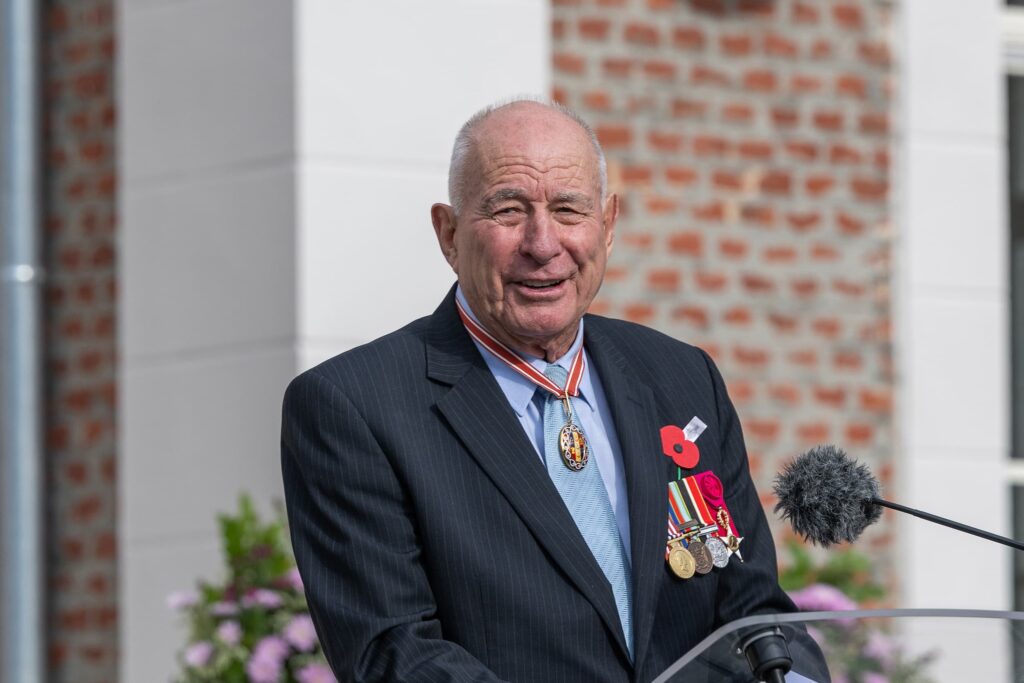
SPEECH BY SIR DON MCKINNON
I want to first acknowledge Mayor Marie Sophie Lesne and Sir Jerry Mataparae, one of New Zealand’s most distinguished sons.
Allow me to recognise: distinguished business and political leaders from France and New Zealand, distinguished leaders and former leaders of Government and the Armed Forces, the special guests representing Te Rūnanga o Ngāti Waewae and Te Arawa, Tena Korua.
Your Excellencies.
Our very good friend from Beaudignies the former Mayor Raymonde Dramez.
Fellow trustees and strategic advisors.
Ladies and gentlemen.
In 1997, Clare and my son Peter made our first visit to Le Quesnoy. It was special, there was a deep connection and it was certain that we would come back. In 1997, the sole plaque on the rampart looked lovely but lonely and as the son of a Major-General we knew it did not fully explain connection between Le Quesnoy and New Zealand. I want to thank Herb Farrant and Greg Moyle who got things moving in the first instance. From 2014, with the enthusiasm of the newly elected Mayor Mme Lesne things really picked up pace as she demonstrated her commitment to the concept and her enthusiasm for the cause. A huge number of people have been involved, here in Le Quesnoy and in New Zealand – it’s been a challenge, a jig-saw puzzle of sorts and today I feel we can say we have completed the picture. It is such a credit to the many skills and talents involved.
Very importantly people have given money, from $10- $100- $1000- $100,000 to the millions. Without those generous donors we would not be here. I must single out some of our outstanding supporters. Richard Izard, from Taupo, Brendon and Jo Lindsay and their family who have given us “real horsepower” beyond our wildest hopes.
Murray Bolton from Bolton Equities
The Douglas Family
Peter Menzies
The Mark Stewart family
Westpac New Zealand
Andrew Barnes and Charlotte Lockhart
The Garfield Weston Foundation
Sir Paul and Lady Cheryl Adams
Peter and Sue Cooper
Josephine and Ross Green
The Hynds Trust
Peter and Fiona Thompson
And the Waipa District Council
Collectively those I have just mentioned have produced 81% of our funds.
We have 400 other donors who are truly valued and I thank them too.
We also have very esteemed friends who have donated and also lent their names and status to Te Arawhata: former Prime Minister of New Zealand, Helen Clark, Sir Jerry Mateparae, Dame Jenny Gibbs, Dame Patsy Reddy, Sir Anand Satyanand and Mark Averill.
And very special close colleagues and friends – of whom all were volunteers: Sir Lockwood Smith, Mark Hall, Celia Caughey, Peter McKinnon, Bruce Bernacchi, Andrew Collow, Kerry Underhill, Pierre Bourgeois, Ben Upton, Natalie Philippe, Robert Hanson and Richard Hanson
Someone has calculated they have collectively given more than 38,500 hours to date.
I want to acknowledge our paid professionals who have gone well beyond their salaried, paid time: Jenni Giblin, Luke van Velthooven, Jude Dobson, Adele McNutt.
Our very dear friend Rosaria Campbell has been integral to ensuring a smooth running of all the complex parts and people involved in making Te Arawhata a reality. Rosaria would love to be here today, I feel her presence, and we all wish her a full recovery.
To all the professionals and contractors here in Le Quesnoy and the great team of 119 people from Wētā Workshop, many thanks to all of you.
It would be wrong for me to finish without most importantly remembering and thanking those young men from New Zealand who gave so much – 196 of them lost their lives
I conclude with a Māori proverb of Te Rūnanga Ngāti Waewae, here today and who blessed Te Arawhata yesterday.
Mō tātou, ā, mō kā uri, ā muri ake nei
Our decisions are for today’s generation, the generation of tomorrow, and those not yet born.
That’s what this is all about, to ensure future generations do not forget. The challenge to you all here today is to undertake to bring your grandchildren here to engage them. And commit them to bring their grandchildren here to also be engaged. If all here do that Madam Mayor (Marie Sophie Lesne of Le Quesnoy) that should take care of the next 100 years.
No reira Tēnā kotou katoa.
SIR DON MCKINNON (FRENCH)
Tout d’abord, je souhaite remercier Madame le Maire Marie-Sophie Lesne et Sir Jerry Mataparae, l’un des plus éminents fils de la Nouvelle-Zélande.
Permettez-moi de saluer: les éminents représentants politiques et représentants d’entreprises de France et de Nouvelle-Zélande.
Les éminents représentants et anciens représentants du gouvernement et des forces armées.
Les invités d’honneur représentant Ngati Waewae et Te Arawa, Tena Korua
Vos Excellences.
Notre très bonne amie de Beaudignies, l’ancienne maire Madame Raymonde Dramez.
Nos amis fiduciaires et conseillers stratégiques.
Mesdames et messieurs.
En 1997, Clare, mon fils Peter et moi-même sommes venus au Quesnoy pour la première fois. C’était spécial, il y eut une connexion profonde avec la ville et le fait que nous reviendrions un jour ici était une certitude.
En 1997, bien que l’unique plaque sur le rempart était jolie elle paraissait un peu seule et, en tant que fils d’un Major Général, nous savions qu’elle n’expliquait pas pleinement la longue et émouvante connexion entre Le Quesnoy et la Nouvelle-Zélande.
Je souhaite remercier Herb Farrant et Greg Moyle qui ont été les premiers à faire avancer les choses. Depuis 2014, avec l’enthousiasme de Madame Lesne alors nouvellement élue maire, le projet a vraiment connu une impulsion grâce à son énergie et son implication pour cette cause.
Un grand nombre de personnes ont été impliquées dans ce projet, ici au Quesnoy et en Nouvelle-Zélande – ce fut un défi, un puzzle en quelques sortes et aujourd’hui j’ai le sentiment que nous pouvons affirmer avoir complété le tableau. C’est un véritable hommage aux innombrables compétences et aux nombreux talents impliqués.
De manière très importante, des gens nous ont donné de l’argent ; 10 dollars, 100 dollars, 1000 dollars puis 100 000 et même des millions. Sans ces généreux dons, nous ne serions pas là.
Je dois mettre en avant certains de nos soutiens exceptionnels.
Richard Izard, que vous avez vu à l’écran depuis Taupo,
Brendon et Jo Lindsay ainsi que leur famille qui nous ont donné une « vraie impulsion » au-delà de nos espoirs les plus fous.
Murray Bolton de Bolton Equities
La famille Douglas
Peter Menzies
La famille de Mark Stewart
Westpac New Zealand
Andrew Barnes et Charlotte Lockhart
La fondation Garfield Weston
Sir Paul et Lady Cheryl Adams
Peter et Sue Cooper
Josephine et Ross Green
Le Hynds Trust
Peter et Fiona Thompson
Et le conseil général de Waipa
À eux seuls, ils nous ont permis de lever 81% des fonds nécessaires. Nous avons 400 autres donateurs que nous estimons sincèrement et que je remercie également.
Des amis très estimés nous ont aussi fait parvenir des dons et ont prêté leurs nom et statut à Te Arawhata: L’ancienne Première Ministre Helen Clark, Sir Jerry Mataparae, Dame Jenny Gibbs, Dame Patsy Reddy, Sir Anand Satuanand et Mark Averill.
Et des amis et collègues très proches – tous bénévoles: Sir Lockwood Smith, Mark Hall, Celia Caughey, Peter McKinnon, Bruce Bernacchi, Andrew Collow, Kerry Underhill, Pierre Bourgeois, Ben Upton, Natalie Philippe, Robert Hanson et Richard Hanson
Quelqu’un a fait le calcul et ils nous ont collectivement offert plus de 38 500 heures à ce jour.
Je veux saluer nos professionnels rémunérés qui ont travaillé bien au-delà de leurs heures salariées : Jenni Giblin, Luke van Velthooven, Jude Dobson, Adele McNutt
Notre très chère amie Rosaria Campbell a été cruciale dans la gestion de tous les aspects complexes et des personnes impliquées à la réalisation du projet Te Arawhata. Rosaria aurait aimé être avec nous aujourd’hui mais je sens sa présence et nous lui souhaitons tous un prompt rétablissement. À tous les professionnels et entrepreneurs ici au Quesnoy ainsi qu’à la formidable équipe de 119 personnes de Wētā Workshop, un grand merci à vous tous.
Ce serait mal venu de ma part de conclure sans une pensée et un remerciement à tous ces jeunes hommes venus de Nouvelle-Zélande qui ont tant donné : 196 d’entre eux ont perdu la vie.
Je conclurai avec un proverbe maori de Te Rūnanga Ngāti Waewae, ici présent et qui a béni Te Arawhata hier.
Mō tātou, ā, mō kā uri, ā muri ake nei
Nos décisions sont prises pour la génération d’aujourd’hui, la génération de demain et de ceux qui ne sont pas encore nés.
C’est le but de tout cela : nous assurer que les générations futures n’oublient pas.
Votre défi à vous tous aujourd’hui est de vous engager à faire venir vos petits-enfants ici afin de les impliquer. Et qu’ils s’engagent à faire venir leurs propres petits-enfants afin de les impliquer à leur tour.
Si nous tous ici faisons cela, Madame le Maire, les 100 prochaines années devraient être assurées.
Photo by Eric Compernolle
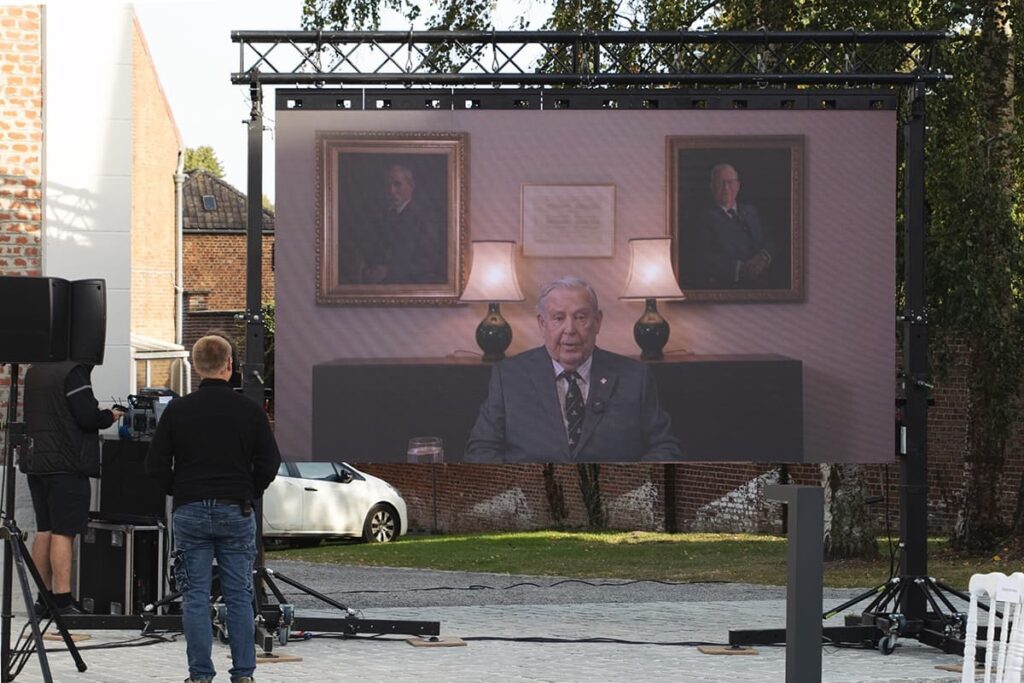
RICHARD IZARD SPOKE AT THE OPENING CEREMONY VIA VIDEO MESSAGE
Bonjour I am Richard Izard I come from a little town called Taupō with a beautiful lake in New Zealand.
I would have loved to have travelled to the opening, but my doctors have told me ‘no travel at this stage boy, get yourself right’ and then I will be coming to see you at the Anzac Parade next year and I am looking forward to that very much and also coincidentally it is my 90th birthday.
The project is brilliant. I believe that the fact that we had 100,000 people take part in the first world war and we have 12,000 people buried on French soil, the honour of the work they did is incredible.
The project captured my interest because of the fact that the honour was more than due, and a permanent honour is really, really wonderful for the families of the people that lost their loved ones, for the French also to celebrate the fact that we were there and I believe that it is something that I could not bypass.
My thoughts were that it was a fantastic thing to do, it is more than called for, and from a point of view of our relations with France and for New Zealand, it is highly appropriate and for the families of the people who took part.
What captured my interest mostly was the fact that the town has a fantastic reputation for what went on, it is absolutely fascinating by anybody’s terms, and it is a story that will live forever – that really did mean a lot to me.
I have French ancestors on both sides, my mother’s family were de Lautour’s and I am an Izard (say in French).
The reason I did this is because I wanted to acknowledge what had gone on from little New Zealand to mighty France which I adore, and here was an opportunity at my age to do something before I go.
I hope you will all enjoy the magnificent display that is being put on, the perpetrators of that are not only well known, they are exceptional, and it is something that you should all see and encourage people to come and see and I know their work is really, truly wonderful.
I was delighted to see that Wētā Workshop were making the visitor experience, I have seen it in Wellington and I am looking forward to seeing it in Le Quesnoy and I recommend to you all to get your friends to see it as they will be mind-blown, it is a fantastic display, they are well known for exceptional work worldwide.
Bonne chance everyone
Au revoir
Richard Izard is on his way.
Discours de Richard Izard (French)
Bonjour! Je suis Richard Izard. Je viens d’une petite ville de Nouvelle-Zélande qu’on appelle Taupō, où il y a un magnifique lac.
J’aurais aimé faire le voyage pour l’inauguration mais mes docteurs ont insisté: “Pas de voyages à ce stade, mon gars, rétablis-toi!” Et alors, j’aurai le droit de venir vous voir pour le défilé de l’ANZAC Day l’année prochaine. J’attends ça avec beaucoup d’impatience, d’autant plus que ce sera mon 90ème anniversaire.
Le projet est splendide. Je crois que pour les 100 000 personnes qui ont participé à la Première Guerre mondiale et les 12000 personnes enterrées sur le territoire français, le travail effectué en leur honneur est incroyable.
Le projet a capté mon intérêt car il était plus que temps de rendre cet hommage. Un hommage permanent est vraiment, vraiment merveilleux pour les familles qui ont perdu leurs proches. Mais aussi pour que les Français puissent célébrer notre présence ici par le passé. Je pense que c’était incontournable.
Mon avis est que c’est un fantastique projet, plus que nécessaire et hautement approprié dans le cadre de la relation entre la France et la Nouvelle-Zélande. Ça l’est tout autant pour les familles de ceux qui y ont participé.
Ce qui m’a tout particulièrement intéressé fut le fait que la ville garde une excellente renommée après ce qui s’est passé, tout le monde s’accorde pour dire que c’est absolument fascinant et que cette histoire vivra pour toujours. Ça a vraiment signifié beaucoup pour moi.
J’ai des ancêtres français des deux côtés de ma famille, la famille de ma mère s’appelait de Lautour et je suis un Izard (à prononcer en français).
La raison pour laquelle j’ai participé à ce projet est parce que je voulais que l’on reconnaisse tout ce qui s’était passé depuis la petite Nouvelle-Zélande vers la puissante France que j’adore. C’était l’opportunité, à mon âge, de faire quelque chose avant de partir.
J’espère que vous apprécierez toutes et tous la magnifique vitrine mise à votre disposition. Ses auteurs ne sont pas seulement connus de tous, ils sont aussi exceptionnels. C’est un lieu que vous devriez toutes et tous voir et promouvoir. Je sais que leur travail est vraiment, réellement merveilleux.
J’étais enchanté que Wētā Workshop crée cette expérience pour les visiteurs. Je l’ai vue à Wellington et suis impatient de la voir au Quesnoy. Je vous recommande à toutes et tous de faire venir vos amis car ils vont être ébahis. C’est une exposition fantastique, Weta Workshop est connu de par le monde pour son travail exceptionnel.
Bonne chance, tout le monde
Au revoir
Richard Izard (prononcé en français) arrive.
Photo by Anna Birchall
STRATEGIC ADVISOR TO THE TRUST CELIA CAUGHEY
We would also like to acknowledge Brendan and Jo Lindsay of the Lindsay Foundation, who have been game changers for the project. The timing of their significant financial contributions, totalling $3.5m, permitted the project to be completed in one stage. They have also provided in-kind and other financial support for those delivering the project. Their energy and enthusiasm have ensured we could deliver the museum on time and with the appropriate professional expertise. For this relentless pursuit of excellence in realising our vision, the trust is deeply grateful.
STRATEGIC ADVISOR TO THE TRUST CELIA CAUGHEY (French)
Nous tenons également à remercier Brendan et Jo Lindsay de la Fondation Lindsay qui ont permis au projet de passer à une vitesse supérieure. Le calendrier de leurs importantes contributions financières, totalisant 3 virgule 5 millions de dollars, a permis de réaliser le projet en une seule étape. Leur énergie et leur enthousiasme ont permis au musée d’ouvrir ses portes aujourd’hui, riche de toute l’expertise professionnelle appropriée. Pour cette quête incessante de l’excellence dans la réalisation de notre vision, le trust leur exprime une reconnaissance toute particulière.
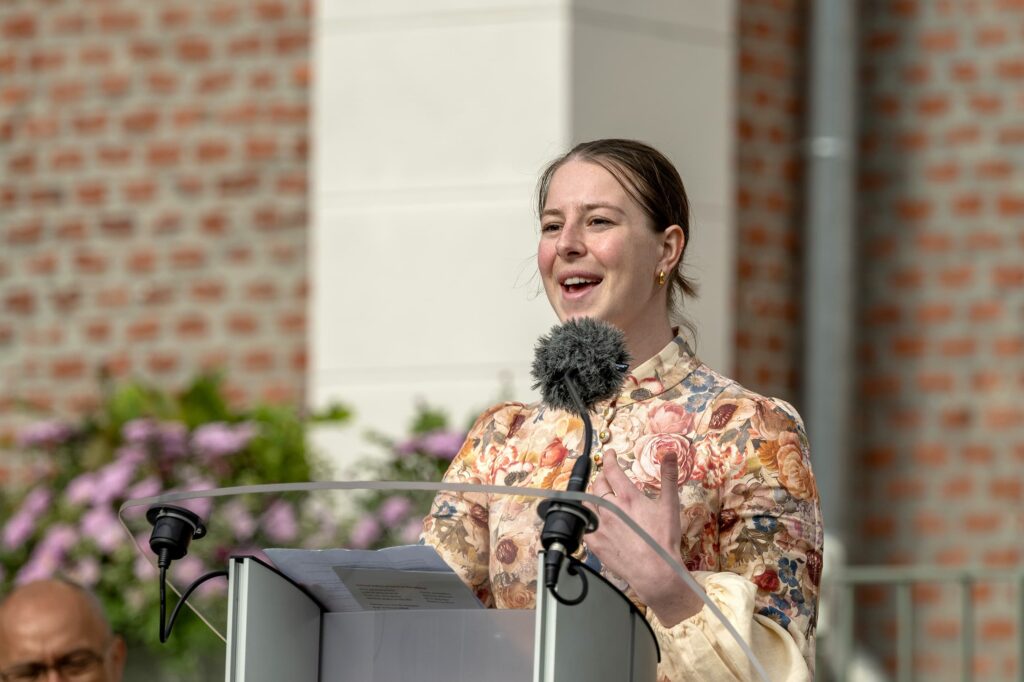
SPEECH FOR THE OPENING CEREMONY – FELICITY WILSON
Standing here today is not just a privilege; it’s an honour beyond words because today, with the opening of these doors, we have immortalised an extraordinary chapter in history.
And, as I stand here today, knowing that so many of you have contributed to making this museum, I am in awe of your dedication and hard work.
This museum houses the personal stories that chronicle the sacrifices made in the past, as well as cementing bond between New Zealand and the people of Le Quesnoy which endures to this day.
It is a sanctuary that recalls the harrowing realities of war and also underscores the innate compassion and solidarity of strangers, separated by vast distances, yet bound by experiences.
The NZ Liberation Museum – Te Arawhata serves as a testament to this connection, reminding us that the legacy of these brave individuals lives on in our hearts and continues to shape our values, our aspirations, and our friendships.
I also remember those soldiers who lost their lives, soldiers who had not only freed a town but also captured the spirit of camaraderie and self-sacrifice that defines the ANZAC legacy.
Among them, a young soldier with whom I share a family farm, and my last name, my great-great-uncle, Gladstone Wilson.
I now wish to speak to Uncle Gladstone.
While I cannot turn back the hands of time to mend your wounds, I can tell you that everything at home is okay.
The oak trees you planted stand tall and unwavering. It is still as green as far as the eye can see and the rolling terrain still dances.
The sheep have been shorn, the horses still leap over fences, and the occasional cow still escapes onto the road.
I want you to know Gladstone, that the fern that is carved around your name on your headstone here in France, is the same New Zealand plant I see every day as I walk to work.
In your honour, Uncle, I want you to know that despite the generational time that has passed, I will remember the sacrifice you made.
You will be remembered here in Le Quesnoy as a soldier who gave everything, you will be remembered in New Zealand as a soldier who fought and died for his country, you will be remembered for the path you paved, and you will forever be remembered by me because you are my great- great uncle and we share the same last name.
DISCOURS POUR LA CEREMONIE D’OUVERTURE – FELICITY WILSON (French)
Me tenir devant vous aujourd’hui n’est pas un simple privilège; c’est un honneur, au-delà des mots, car aujourd’hui, avec cette inauguration, nous immortalisons un incroyable chapitre de l’Histoire. Et alors que je me tiens devant vous aujourd’hui, sachant que vous êtes si nombreux à avoir contribué à la création de ce musée, je suis émerveillée par votre dévouement et votre travail acharné. Ce musée accueille des histoires personnelles qui racontent de façon détaillée les sacrifices faits dans le passé, mais renforce aussi le lien qui perdure entre la Nouvelle-Zélande et la population du Quesnoy. C’est un refuge qui rappelle l’éprouvante réalité de la guerre mais souligne aussi la compassion innée et la solidarité entre étrangers, séparés par de vastes distances et pourtant liés par tant d’expériences. Le Musée néo-zélandais de la Libération – Te Arawhata témoigne de cette connexion et nous rappelle à toutes et tous que l’héritage de ces braves soldats vit dans notre coeur. Il continue de modeler nos valeurs, nos aspirations et nos amitiés. Je pense aussi à ces soldats qui ont perdu leur vie, ces soldats qui n’ont pas seulement libéré une ville mais se sont aussi emparés de l’esprit de camaraderie et d’abnégation qui définit l’héritage de l’ANZAC. Parmi eux, un jeune soldat avec qui je partage une ferme familiale ainsi que mon nom de famille, mon arrière-grand-oncle, Gladstone Wilson.
Je souhaiterais maintenant m’adresser à Oncle Gladstone.
Bien que je ne puisse pas remonter le temps pour panser tes blessures, je peux t’assurer que tout se passe bien à la maison. Les chênes que tu as plantés demeurent grands et inébranlables. Tout est toujours vert, aussi loin que l’on puisse voir, et le terrain vallonné continue de danser. Les moutons sont tondus, les chevaux sautent par-dessus les clôtures et il y a toujous une vache qui réussit à s’échapper sur la route. Je veux que tu saches, Gladstone, que la fougère gravée autour de ton nom sur la stèle ici en France est la même plante néo-zélandaise que je vois chaque jour sur la route du travail. En ton honneur, cher Oncle, je veux que tu saches: bien qu’une génération soit passée, je me souviendrai du sacrifice que tu as fait. On se souviendra de toi ici au Quesnoy comme d’un soldat qui a tout donné. On se souviendra de toi en Nouvelle-Zélande comme d’un soldat qui a combattu et est mort pour son pays. On se souviendra de toi pour la voie que tu as ouverte. Et je me souviendrai toujours de toi parce que tu es mon arrière-grand-oncle et que nous partageons le même nom.
Photo by Eric Compernolle
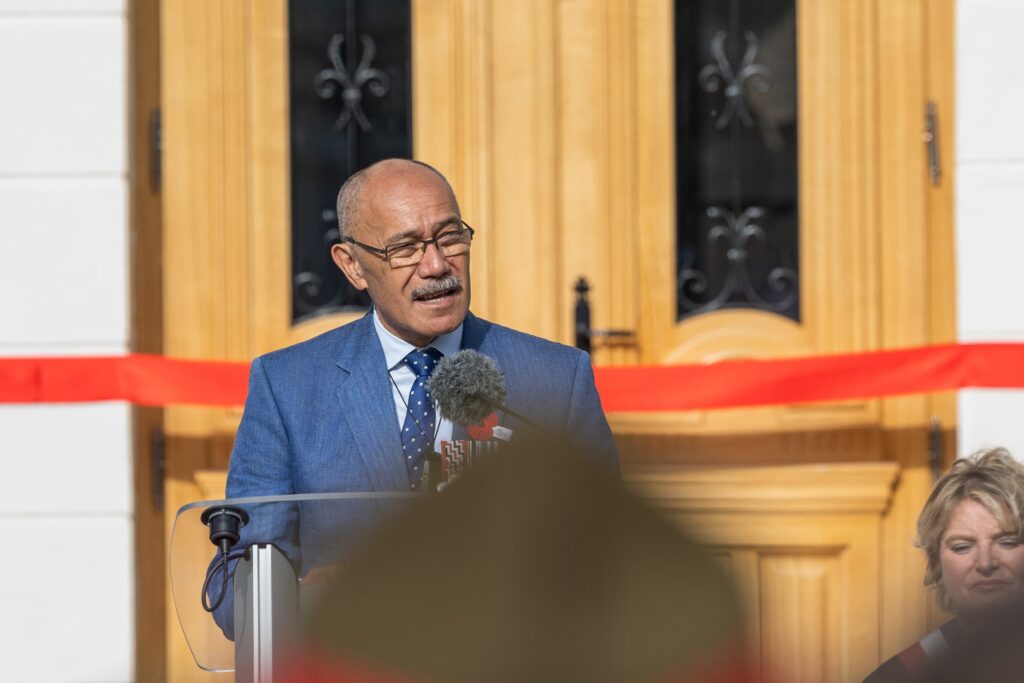
SPEECH BY SIR JERRY MATEPARAE
Le Quesnoy
Bonjour mesdames, messieurs, garçons et filles. I am honoured to join you here, together with the Mayor of Le Quesnoy – Marie Sophie Lesne – for the opening of The New Zealand Liberation Museum – Te Arawhata.
Each year, on the 25th of April – Anzac Day – New Zealanders attend commemorative services in New Zealand and where ever they happen to be around the world. The 25th of April marks the day in 1915 when soldiers of the Australian and New Zealand Army Corps – the ANZACs – fought their first major battle of the First World War at Gallipoli, in what is now modern-day Türkiye.
It is fitting that New Zealand has a museum here at Le Quesnoy because it is where New Zealand troops fought their last major battle of the First World War and is one of the New Zealand Division’s most spectacular exploits of the war.
There is a Māori proverb that asks: “He aha te mea nui o te ao? – What is the most important thing in the world”, to which the response is “He tāngata, he tāngata, he tāngata” the people, the people, the people. The battle at Le Quesnoy is testament to this proverb.
At 5.30am, on the morning of November 4th 1918, the French First Army and the British Fourth, Third and First Armies started an attack along a 48 kilometre front from Oisy to Valenciennes.
The New Zealand Division was given the task to envelop Le Quesnoy, to push the battle line forward a further nine kilometres and complete the capture and mopping-up of the German garrison at Le Quesnoy later. It was a complex task.
The decision to prevent civilian casualties inside Le Quesnoy is the first notable acknowledgement of the importance of people. The methods used by Private Winiata Tapsell and Second Lieutenant Leslie Averill to gain entry into Le Quesnoy are further examples of the daring and the importance of people – well trained, innovative and determined soldiers. Another New Zealander who warrants mention is Major General Sir Andrew Russell the New Zealand Division’s commander.
Prior to commanding the New Zealand Division in Europe, General Russell had commanded the combined New Zealand and Australia Division at Gallipoli. He was a front-line general, seen to take personal risks. He was one of the few generals in the British armies to display innovation and tactical skill in the First World War.
In contrast to our experience at Gallipoli where our soldiers and commanders lacked warfighting experience, by the time they were fighting at Le Quesnoy the New Zealand Division was one of the best fighting divisions in France. Its commanders were young and very experienced. Most had fought at Gallipoli and then for three long years in Europe.
In Europe and at Gallipoli General Russell fought his Division with great skill. In Europe especially, he insisted on subordinates using every opportunity to learn lessons from each operation. Anticipation and planning were his hallmark. At Messines he showed his mastery of the set-piece attack, and the battles of 1918 showed his mastery of the advance and encounter battle.
General Russell’s command of the New Zealand Division in France is one of exemplary leadership. He vetted his subordinate commanders, and insisted on the best man for the job. He carefully safeguarded his Division’s soldiers to ensure his Division remained battle ready and operationally effective. He insisted upon rigorous training, zealous discipline and efficient administration to ensure his soldiers were properly prepared. His example followed the conviction that to him people were the most important thing in the world.
The capture of Le Quesnoy by the New Zealand Division on 4 November 1918 has special significance in New Zealand’s military history. The last major action by New Zealanders in the First World War and especially because of the way Le Quesnoy was captured make it so. Heavy artillery could have rapidly demolished the walls of Le Quesnoy, and limited casualties to the New Zealanders, but that would have been at a heavy cost to the inhabitants of Le Quesnoy. The tactical methods used to envelop and then capture Le Quesnoy are worth memorialising.
It is also important to remember the intrepid citizens of Le Quesnoy, then and today. During the Great War they endured extreme hardship and today you show great generosity. This museum at Le Quesnoy gives New Zealanders an important place to gather in Europe – it is a place we New Zealanders can call our turangawaewae – our place to stand. It will provide a fitting place where we can remember with sympathy, humility, affection and with pride the men and women of Le Quesnoy and New Zealand who served during the Great War, especially those who served and died.
Ka maumahara tonu tātou ki a rātou – We will remember them.
Discours de Sir Jerry Matepaere (French)
Le Quesnoy
Bonjour mesdames, messieurs, garçons et filles. Je suis honoré d’être avec vous ici, aux côtés de Madame le Maire du Quesnoy – Marie-Sophie Lesne – pour l’inauguration du Musée Néo-zélandais de la Libération – Te Arawhata.
Chaque année, le 25 avril – l’Anzac Day – les Néo-Zélandais assistent aux commémorations, qu’ils se trouvent en Nouvelle-Zélande ou ailleurs dans le monde. Le 25 avril marque le jour en 1915 où les soldats des corps d’armée australiens et néo-zélandais – les ANZACs – ont mené leur première grande bataille pour la Première Guerre mondiale à Gallipoli, en Turquie.
Il est approprié que la Nouvelle-Zélande ait un musée au Quesnoy car c’est ici que les troupes néo-zélandaises ont mené leur dernière grande bataille pour la Première Guerre mondiale et qu’a eu lieu l’un des exploits les plus spectaculaires de la division néo-zélandaise pendant la guerre.
Un proverbe maori demande: “He aha te mea nui o te ao?” – Quelle est la chose la plus importante au monde? La réponse est: “He tāngata, he tāngata, he tāngata.” Les gens, les gens, les gens. La bataille du Quesnoy est un hommage à ce proverbe.
A 5:30 du matin, le 4 novembre 1918, la Première Armée française et la Première, Troisième et Quatrième Armée britannique lancèrent l’attaque sur le front long de 48 kilomètres, d’Oisy jusque Valenciennes.
La division néo-zélandaise reçut l’ordre d’encercler Le Quesnoy, de repousser la ligne de bataille sur 9 kilomètres, et de finaliser la capture de la garnison allemande et le nettoyage du Quesnoy plus tard. La tâche était complexe.
La décision d’éviter les blessés à l’intérieur de la ville du Quesnoy fut le premier signe de l’importance donnée aux personnes. Les méthodes utilisées par le soldat Winiata Tapsell et le Second Lieutenant Leslie Averill pour pénétrer dans la ville sont d’autres exemples de leur audace et de l’importance donnée aux gens. C’était des soldats bien entraînés, innovants et déterminés. Le Major Général Sir Andrew Russell, commandant de la division néo-zélandaise, est un autre Néo-Zélandais qui mérite d’être mentionné.
Avant de commander la division néo-zélandaise en Europe, le Général Russell avait commandé les divisions combinées de Nouvelle-Zélande et d’Australie à Gallipoli. C’était un général de première ligne, qui prenait des risques personnels. C’était aussi l’un des quelques généraux dans les armées britanniques à montrer des compétences innovantes et tactiques pendant la Première Guerre mondiale.
Contrairement à notre expérience à Gallipoli, où nos soldats et commandants manquèrent d’expérience de la guerre, lorsqu’elle combattit au Quesnoy la division néo-zélandaise était l’une des meilleures divisions de combat en France. Ses commandants étaient jeunes et très expérimentés. La plupart s’était battue à Gallipoli puis pendant trois longues années en Europe.
En Europe et à Gallipoli, le général Russell guida sa division avec grande habileté. En Europe, tout particulièrement, il insista pour que ses subordonnées se servent de chaque opportunité qui se présentait pour apprendre de chaque opération. L’anticipation et la planification étaient sa marque de fabrique. A Messines, il démontra sa maîtrise de l’attaque isolée et les batailles de 1918 démontrèrent sa maîtrise de la guerre de mouvement.
Le commandement de la division néo-zélandaise en France par le Général Russell est exemplaire. Il approuvait ses commandants subordonnés et insistait pour que le plus apte effectue la mission. Il protégeait ses soldats afin de s’assurer que sa division reste prête pour la bataille et opérationnelle. Il insistait pour qu’un entraînement rigoureux soit suivi, ainsi que pour la mise en place d’une discipline zélée et d’une administration efficace, permettant la bonne préparation des soldats. Son exemple suivait sa conviction profonde: que les gens étaient ce qu’il y avait de plus important au monde.
La prise du Quesnoy par la division néo-zélandaise le 4 novembre 1918 a une signification très spéciale dans l’histoire militaire de la Nouvelle-Zélande. La dernière grande action par les Néo-Zélandais au cours de la Première Guerre mondiale, et surtout la façon dont Le Quesnoy fut pris, lui confère ce rôle. Une lourde artillerie aurait pu rapidement démolir les murs du Quesnoy et limiter les pertes néo-zélandaises. Mais le coût aurait été élevé pour les Quercitains. Les tactiques utilisées pour entourer puis prendre Le Quesnoy valent la peine d’être retenues.
Il est aussi important de garder en mémoire les habitants intrépides du Quesnoy, alors et aujourd’hui. Tout au long de la Grande Guerre, ils ont enduré des épreuves terribles et aujourd’hui, vous vous démarquez par votre générosité. Ce musée au Quesnoy offre aux Néo-Zélandais un endroit important où se retrouver en Europe – un endroit que nous Néo-Zélandais pouvons appeler notre turangawaewae: notre endroit où rester. Il servira de lieu où nous pourrons nous remémorer avec compassion, humilité, affection et fierté les hommes et les femmes du Quesnoy et de Nouvelle-Zélande qui ont servi pendant la Grande Guerre, et tout particulièrement ceux qui sont décédés.
Ka maumahara tonu tatou ki a rātour – Ne les oublions pas.
Photo by Eric Compernolle
